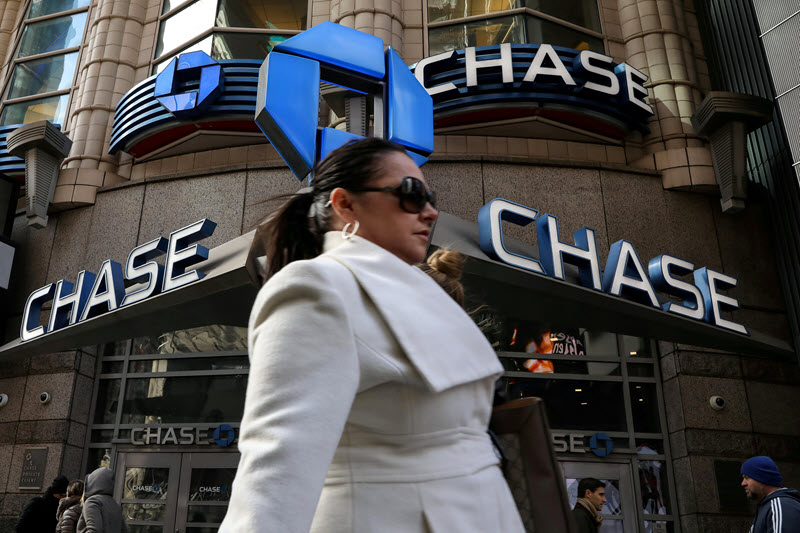By Michelle Price, Saeed Azhar and Tatiana Bautzer
WASHINGTON (Reuters) -Major U.S. banks reported lower profits on Friday in a choppy fourth quarter clouded by special charges and job cuts, with signs an income boost from high interest rates is waning and some consumer loans are starting to sour.
Still, the country’s largest lenders JPMorgan, Wells Fargo, Bank of America, and Citigroup struck an upbeat tone on the economy, noting that American consumers remained resilient even as defaults on consumer loans began returning to pre-pandemic levels.
“This has been a period of credit normalization but the banks have been well ahead in terms of their reserves,” said Mac Sykes, portfolio manager at Gabelli Funds, which holds shares in JPMorgan, Bank of America and Wells Fargo.
“The wild card will be how the economy tracks this year but the big banks are well situated to handle any stress.”
The Federal Reserve hiked rates last year in a bid to tame inflation. But with price increases slowing, the potential pace of interest rate cuts this year, and whether the economy will avoid a recession, are the key questions hanging over markets.
Jamie Dimon, CEO of JPMorgan Chase (NYSE:), the biggest U.S. bank and a bellwether for the economy, said consumers were still spending and that the markets were expecting a soft landing, but warned government spending could continue to push prices higher.
U.S. consumer prices increased more than expected in December, with Americans paying more for shelter and healthcare.
“This may lead inflation to be stickier and rates to be higher than markets expect,” Dimon said.
He also warned Fed rate cuts could drain system liquidity, and that the wars in Ukraine and the Middle East could cause global disruptions.
“These significant and somewhat unprecedented forces cause us to remain cautious,” he added.
Wells Fargo Chief Financial Officer Mike Santomassimo also said rate cuts created more market uncertainty than usual.
JPMorgan shares pared earlier gains and was down 0.27%. Citi gained 0.57%, while Bank of America fell 0.66% and Wells Fargo was down 3.09%. The industry-wide was down 0.98%.
The banks combined set aside more than $8 billion to refill the government’s deposit insurance fund (DIF), which took a $16 billion hit after Silicon Valley Bank and two other lenders failed last year.
Citi, the most global U.S. bank which is in the throes of a huge reorganization, had a dismal quarter, swinging to a surprise $1.8 billion loss on the DIF charges and as it stockpiled cash to cover currency risks in Argentina and Russia.
Citi will cut 20,000 jobs over the next two years, its CFO Mark Mason said.
Wells Fargo, which has also been undergoing a turnaround to fix longstanding problems, reported a $969 million expense on job cuts, along with a $1.9 billion DIF charge.
Bank of America also cut jobs last year, it said, bringing total cuts for the three banks to 17,700 in 2023.
NII MIXED
Beyond one-off charges, the core revenue picture was mixed.
High rates last year boosted banks’ net interest income (NII), the difference between what they earn from loans and pay to depositors, but that revenue driver looks to be flagging as the Fed pauses hikes, loan growth slows, and banks pay more to retain deposits.
Bank of America’s profit more than halved on the DIF charge, a one-off hit on how it indexed some trades, and a 5% decline in its NII on higher deposit costs and as demand for loans stayed subdued amid high rates.
Of the four, Wells Fargo was the only lender to post a jump in profits, which rose 9% thanks to cost cuts, beating analyst expectations. But NII fell 5%, and it warned that 2024 NII could be 7% to 9% lower than a year earlier due, in part, to lower rates and an expected decline in average loans.
JPMorgan also put in a strong performance. Its quarterly profits fell 15%, but the Wall Street giant posted a record annual profit of $49.6 billion and a 19% jump in NII.
“My biggest worry is (did) the benefit of interest rates already occur?,” David Wagner, portfolio manager at Aptus Capital Advisors, which holds the four banks, wrote in an email.
Investment banking was a bright spot, as the prospect of rate cuts has buoyed stock markets, and executives said deal pipelines looked robust. BofA’s investment banking fees were up 7%, while JPMorgan’s climbed 13% on strong equity and debt underwriting.
Custody giant BNY Mellon (NYSE:) also beat analyst estimates on strong interest revenue.
“We see some slowing in the U.S. economy potentially ahead, but not a recession,” BNY Mellon CEO Robin Vince told reporters. “To be able to pull off a perfect, immaculate landing without any other real repercussions in the economy…is a tough thing to do.”
SOURING LOANS
All the lenders set aside more money to cover souring loans, and charge-offs – debts that are unlikely to be recovered – rose on some consumer loans.
Charge-offs at Bank of America – which has the biggest consumer bank – rose to $1.2 billion from $931 million in the third quarter, mainly from credit cards and office real estate.
Consumer delinquencies had declined during the pandemic, as government stimulus and lockdowns boosted consumer savings.
JPMorgan Chase CFO Jeremy Barnum said that the bank’s consumer credit metrics, including credit cards, had returned to normal. Citi said U.S. personal banking credit costs were rising due to “continued normalization” of non performing credit card loans.
Credit card loss rates are still below long run averages, according to ratings agency Fitch. Some analysts, however, said they would like to see banks putting more cash aside in case credit trends worsen.
“I’m not super worried…but my preference is that banks build reserves in this environment,” said Chris Marinac, director of research at financial adviser Janney Montgomery Scott.
Read the full article here











